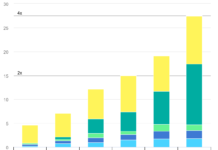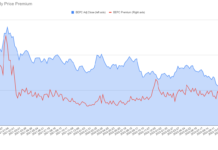By Greg Pfahl
Renewable IPOs in 2010
2010 proved to be a much better year for the initial public offering and renewable energy companies, perhaps surprisingly, saw their share of activity. In 2010 there were more than double the number of initial public offerings than in 2009, and we also saw a significant increase in secondary offerings as well.
Worldwide public investment in renewable energy increased 21 percent last year, with China representing 20 percent of the 2010 market, according to VB/Research of London. The REW 40 Index is up 15 percent over the past year at this writing. While it’s hard to predict if 2011 will be a frothy IPO market for renewable companies, it is clear the public’s appetite for risk in renewables is growing. Despite what you may hear about the effect of lower natural gas prices on renewables, we believe that it is public market performance and availability of willing investors, not commodity prices, that drives the IPO market.
The renewable IPO field saw a series of fits and starts. There were some fits: Solyndra, PetroAlgae (PALG.OB), Trony Solar and Gevo (GEVO) withdrew or reduced their IPOs. But there were some starts as well. Even though Codexis (CDXS) didn’t raise the $100 million it had hoped for last April, it still pocketed $78 million from public investors with its IPO. And Amyris is trading at the $30 level, nearly double the IPO of $17.20.
Codexis and Amyris (AMRS) both succeeded on their IPOs because despite the fact they are money-losing early stage companies, they have proven technology and real revenues and contracts, with potential high-revenue products in the pipeline. Codexis, which develops custom enzymes and catalysts for industrial chemical production, has a project going with Shell, a major investor, to speed up production of biofuels from nonfood sources. Codexis had revenues of $101.5 million last year.
Amyris had revenues of $68.5 million for its synthetic biofuels technology. The company has been well-funded by venture capital investors as it tries to show it can be “the leading provider of renewable specialty chemicals and transportation fuels worldwide.” The company’s Biofene yeast-based chemical takes Brazilian sugarcane and ferments it into a petroleum replacement into several different applications, including diesel and jet fuel. Amyris has benefited from consistently telling its story in a convincing way to investors and the public.
California-based photovoltaic maker Solyndra withdrew its IPO in late June citing “ongoing uncertainties in the public markets,” opting for a $175 million private placement and a $535 million loan guarantee from the federal government instead. The Solyndra withdrawal was described by some observers as “muddying the waters” for other solar panel makers to hit the markets, but considering the company had private and government options, it was only prudent for management to pull the $300 million public offer until a better time.
PetroAlgae, on the other hand, is an example of what not to do. The VentureBeat website cited PetroAgae as one of its worst clean tech investments of 2010. The site said most analysts said the company “jumped the gun” because it has burned through $58 million the past three years and has no revenues. Worse, it has a complex corporate structure and has already restated its financial statements. Companies need their investors to understand their story in order to buy into it, including the management, technology, corporate structure and business and financial plan. Complex is bad; simple is good.
How to Plan an IPO
The decision to go public is complex, situational and a big step for any company. Not all IPOs are huge. According to Keating Capital/Capital IQ, 85 percent of NASDAQ companies have market caps less than $1 billion and 40 percent of listed companies are unprofitable. About 10 percent had revenues less than $10 million. If your company determines that an IPO is the correct decision, companies should know what to expect and how to prepare for an IPO, because it isn’t all about the money.
Start early
This is not a fast process. If you are operating on a shoestring budget and have three months worth of cash, the IPO is not for you because an IPO will not get done in three months. Going public can take six months but more likely will take a year. So if funds are dear, consider government grants or loan guarantees, selling tax credits, selling to private institutional investors, bank financing if you have assets that can be used as collateral, licensing your technology or other fundraising activities.
Still interested? Here are some issues that could trip you up on your way to watching the closing hit the bank if not accomplished at least six months prior:
Solid financials – You might expect an auditor and CPA to say you need quality financial reporting, but you’ll hear the same thing from underwriters, securities attorneys and investors. The smarter clients considering either an IPO or even a private sale get us involved several years before the deal. Renewable companies are in their early stages. Investors understand that there will be losses until a profit is made, but audited financials by a reputable firm give you better leverage. Generally, when filing your initial registration statement with the SEC, you will need to include the most recent two years’ balances sheets and the most recent three years’ income statements, statements of equity and cash flows, all audited by an independent audit firm registered with the PCAOB. In addition, if the age of the audited financial statements is more than 129 days old, then you will need to file stub period financial statements which are required to be reviewed by your independent audit firm.
Management – A year in advance, evaluate your existing management team and assemble the best team you can, preferably one with transactional or public company experience.
Board of directors – You should begin assembling a strong, independent board and a complete set of corporate minutes and any governance records. Most private companies operate with a board of directors consisting primarily of management and friends or family members. However, most stock exchanges require that the majority of the board of directors of a company traded on their exchange be independent. In addition, the SEC requires an independent audit committee.
Compensation Disclosure and Analysis – Compensation disclosures have been one of the SEC’s hot buttons over the past several years and as a public company you will need to provide extensive disclosures in your periodic filings. So get the policies and contracts in place prior to going public.
Document material agreements – As part of their due diligence process, the underwriter and their team will be requesting and reviewing all of your material agreements. In addition, you will be required to file as exhibits with the initial registration statement all material contracts outside of the ordinary course of your business. This is where your legal counsel fits in.
Protect your intellectual property – Investors these days need to know what it is you truly own and can defend in court if necessary from patent infringement.
Play defense – This includes anti-takeover provisions and poison-pill takeover measures.
Do a risk assessment – Identify any issues that could affect your company and prepare measures to deal with them. This could vary from legal, market, commodity and political risk to workplace issues.
Prepare for periodic filing requirements – As a public company you will need to file quarterly and annual reports with the SEC within the required timeframes. Prior to going public, ensure that you have systems in place to accommodate these requirements.
You will also need to disclose and report on your internal controls over financial reporting. The requirement to provide an independent auditor’s report on internal controls over financial reporting (commonly referred to as 404b) was removed by the Dodd Frank Act for smaller reporting companies as defined by the SEC, but even for smaller reporting companies, management will have to provide their report on the effectiveness of their internal control over financial reporting. The initial documentation of internal controls and ongoing testing required for this report can be quite time-intensive. Some companies are handling this all internally and others are outsourcing but the process can and should be started before going public and not afterward.
Selection of an Underwriter – About six months prior to the IPO, management needs to select an underwriter, who will ultimately market the transaction. Some important considerations in making this selection are as follows:
- Industry expertise
- Size of firm, bigger is not always better
- Their perceived commitment to your company both before and after the offering
- Their backlog of deals, are you going to be number one on the list or number one hundred?
The underwriter will have its own SEC counsel who will work closely with your own. At this point, the registration statement will begin to be drafted. Once filed, the SEC will review the document and provide comments, generally within thirty days. Within a week to two weeks you will then respond to the SEC’s comments and file an amended registration statement. The SEC will review the amendment typically within about a week and potentially provide additional comments. Because of these iterations of comments and responses, the SEC review process can potentially slow down the transaction’s closing. It is not uncommon during this process to establish direct contact with the SEC to clarify their concerns and to help expedite the process, normally handled by outside counsel and auditors with SEC experience.
The Road Show – One of the last activities for management prior to closing is the road show, where you make presentations to syndicate members, potential institutional investors and retail brokerages. Management’s job in these presentations is to respond to questions and present the company, not hype the deal. While you can get into projections, you should stick to facts as much as possible.
About the author
Greg Pfahl, CPA, is an audit partner in the Denver office of Hein & Associates LLP, a full-service public accounting and advisory firm with additional offices in Houston, Dallas and Southern California. He also serves as a local leader for the alternative energy practice area. Pfahl can be reached at gpfahl@heincpa.com or 303.298.9600.








